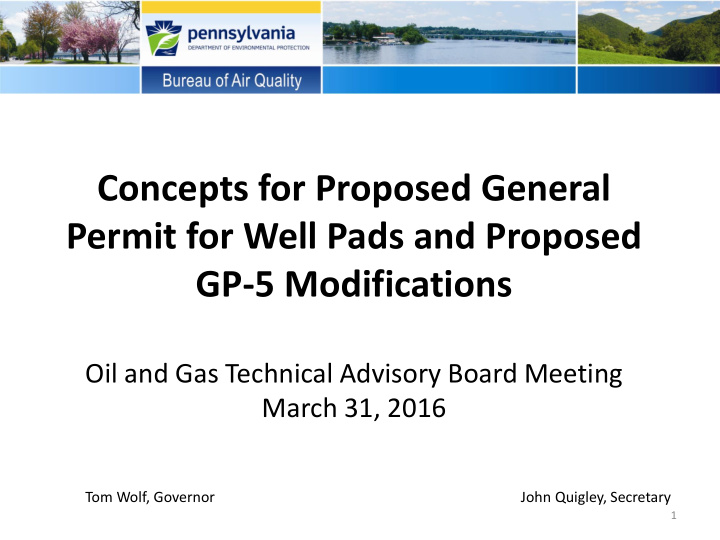



Concepts for Proposed General Permit for Well Pads and Proposed GP-5 Modifications Oil and Gas Technical Advisory Board Meeting March 31, 2016 Tom Wolf, Governor John Quigley, Secretary 1
Background • On January 19, 2016 Governor Tom Wolf announced a four- point methane emission reduction strategy for Oil and Gas operations. DEP will develop a new general permit for new unconventional well pad operations. DEP will revise its current general permit (GP-5) updating the permitting requirements. DEP will develop a regulation for existing sources for consideration by the Environmental Quality Board. DEP will establish best management practices, including leak detection and repair programs to reduce emissions along production, gathering, transmission and distribution lines. 2
Key Concepts for the proposed New GP for Well Pad Operations • Currently, natural gas compressor stations are permitted under general plan approval and/or general operating permit number 5 (GP-5). • Oil and natural gas wells may be exempted from permitting requirements provided the owner or operator complies with the conditions set forth in plan approval exemption #38. • As part of the Department’s Methane Emission Reduction Strategy, the Department is in the process of developing a new general permit to replace exemption #38 and revising the current GP-5. 3
Key Concepts for the proposed New GP for Well Pad Operations • Most of the substantive requirements for exemption #38 are expected to be included in the new general permit. • The Department is exploring the possibility of requiring that diesel- fired engines used on drill rigs meet the EPA’s Tier 4 standards. • The requirement for leak detection and repair (LDAR) may be similar to the current GP-5, including quarterly LDAR inspections using optical gas imaging system and monthly Audio Video Olfactory (AVO) inspections. 4
Key Concepts for the proposed New GP for Well Pad Operations • The first attempt at leak repair must be done within five (5) calendar days of leak detection. If purchase of parts is necessary, the leak must be repaired within 15 calendar days, after the purchase of parts. • VOC emissions from storage tanks must be controlled by at least 95%. • Permitting requirements addressing fugitive dust control measures may be included. 5
Concepts for the proposed New GP for Well Pad Operations • The Department is exploring the requirement for no-bleed and/or low-bleed pneumatic controllers and pumps. • Emissions from pumps may also be controlled through routing pump discharge streams into a closed loop system or a vapor recovery unit. • The permit may require the operation of pig launchers without venting hydrocarbons into the atmosphere. 6
Concepts for the proposed New GP for Well Pad Operations • The Department is considering that plunger lifts or flaring be required to reduce methane emissions from wellbore liquid unloading. • The permit may explicitly address the emission from produced water impoundment tanks. The Department is exploring the feasibility of add-on controls on enclosed storage tanks or a closed loop system for an efficient reuse of produced water. • Annual compliance certifications may be required to be submitted to the Department by the responsible official, as is the case with the current GP-5. 7
Concepts for GP-5 Modifications • The applicability of GP-5 may be extended to natural gas transmission operations. • The Department may require no-bleed and/or low-bleed pneumatic controllers. • The first attempt at leak repair must be done within five (5) calendar days of leak detection. If purchase of parts is necessary, the leak must be repaired within 15 calendar days, after the purchase of parts. 8
Concepts for GP-5 Modifications • The Department is exploring the requirement that owners and operators prevent venting of VOCs and methane during all compressor maintenance and operational activities. • The Department is considering a requirement that storage tanks must control air contaminant emissions by at least 95%. • The permit may require the operation of pig launchers without venting hydrocarbons into the atmosphere. 9
Concepts for GP-5 Modifications • The Department is considering the requirement to use electric pumps or routing pumps discharged to closed systems when electricity is not available. • Emissions from pneumatic pumps driven by natural gas may also be controlled through routing pump discharge streams into a closed loop system or a vapor recovery unit, or the pumps may be replaced with zero bleed pumps. • The use of dry seals or control of wet seal venting of methane from each compressor by 95%. 10
Useful Links • Methane Reduction Strategy Page • http://www.dep.pa.gov/Business/Air/Pages/Methane-Reduction- Strategy.aspx • Methane Strategy Briefing Paper • http://files.dep.state.pa.us/Air/AirQuality/AQPortalFiles/Methane/ DEP%20Methane%20Strategy%201-19-2016%20PDF.pdf • Methane Strategy Briefing Paper Appendix • http://files.dep.state.pa.us/Air/AirQuality/AQPortalFiles/Methane/ Appendix%20A%20-%20Comparison%20of%20PA- %20EPA%20NSPS%20Proposal-%20CSSD%20- %20CO%20Requirements%20for%20the%20Oil%20and%20Gas%20 Sector%20%2012-15-2015.pdf 11
Krishnan Ramamurthy Chief, Division of Permits 717-783-9476 kramamurth@pa.gov 12
Recommend
More recommend